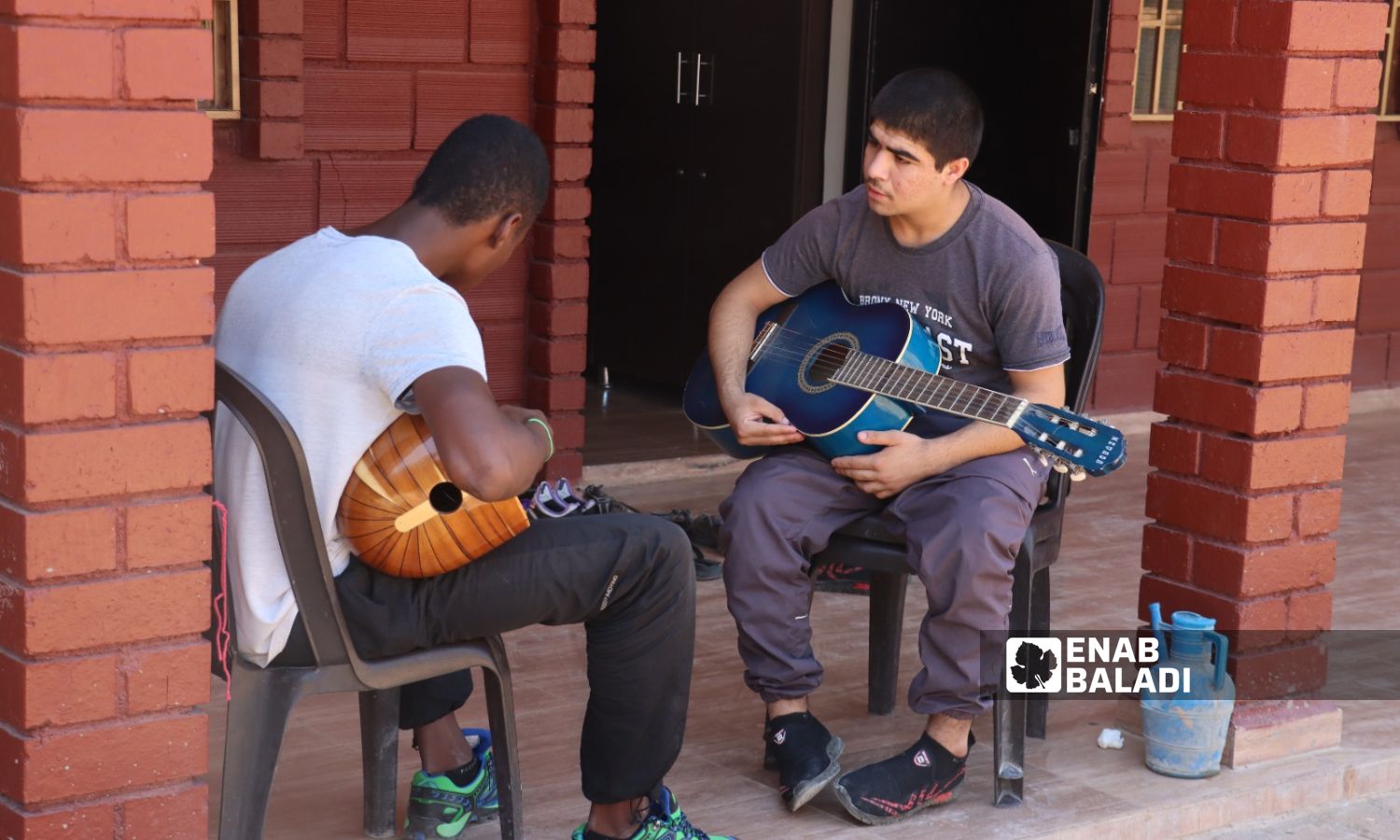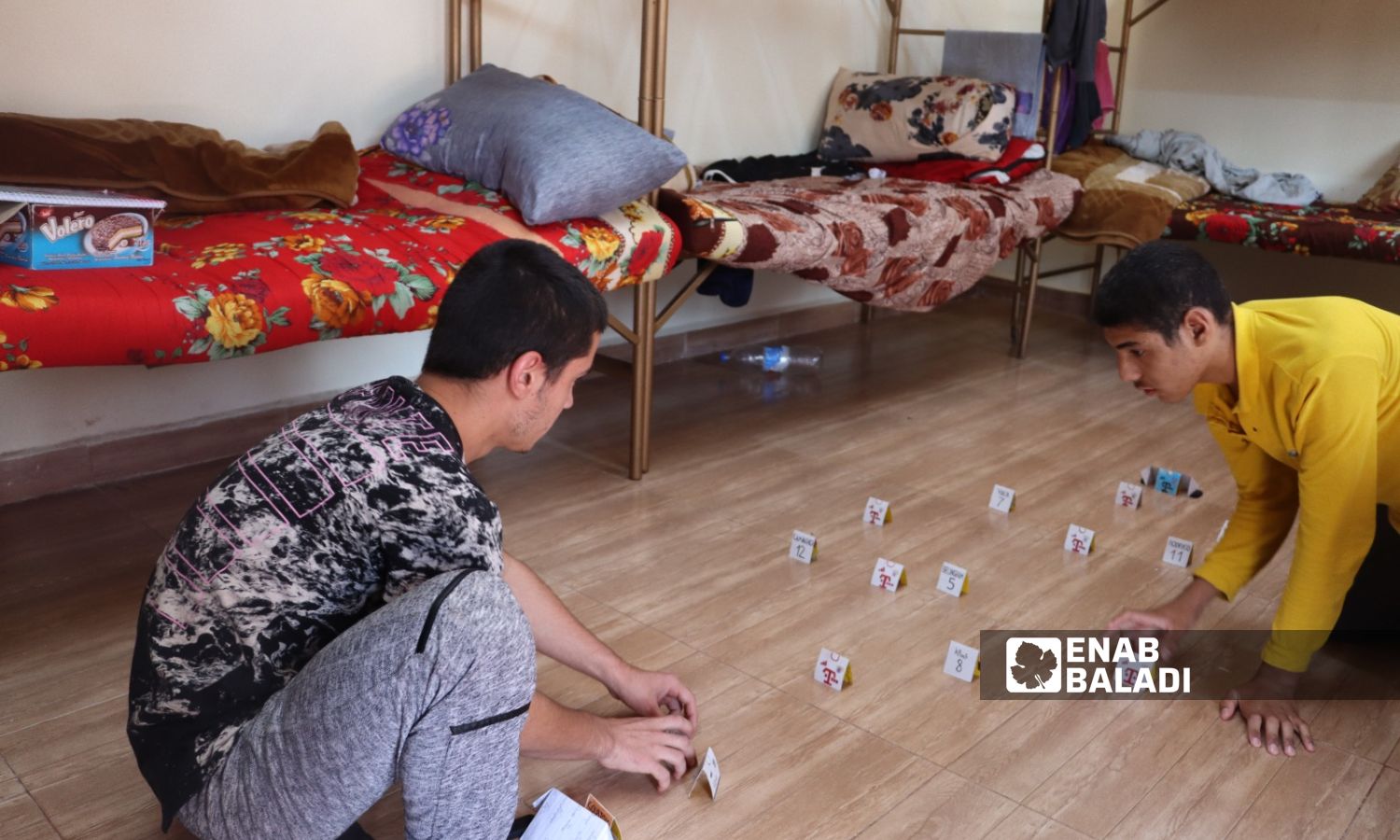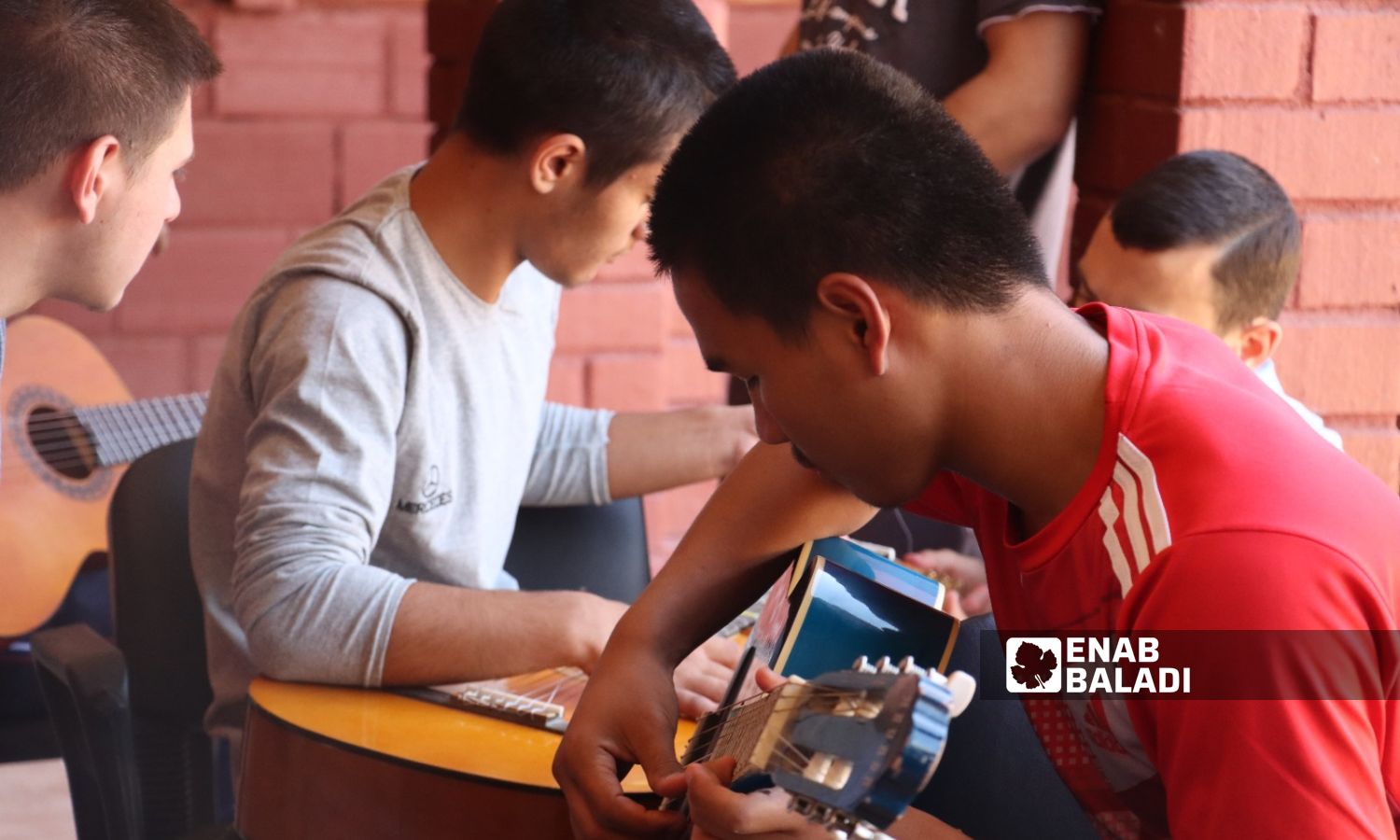



Enab Baladi – Khaled al-Jeratli
Children of Islamic State (IS) fighters have been subjected to rehabilitation programs by the Autonomous Administration of North and East Syria (AANES), the Kurdish-led body said last August. However, these centers are not new in the northeastern al-Hasakah governorate, and Syrian and Iraqi children are excluded from them.
Some rehabilitation centers are surrounded by secrecy, as Enab Baladi tried to contact AANES officials to obtain information about the work of these centers, the mechanisms adopted during the rehabilitation processes, and the organizations supporting them, but it did not obtain a response in this regard.
Enab Baladi, by collaborating with local journalists and workers in rehabilitation centers, was able to enter the Hori center located in the village of Tal Ma’rouf, south of the city of Qamishli, and learned about the programs offered there and the mechanism for dealing with age groups.
On August 14, AANES announced its intention to establish special centers for the rehabilitation and education of minors who are Islamic State prisoners in its areas of influence, given “the seriousness of the issue of dealing with minors who are IS prisoners.”
The administration’s announcement came in a statement published on its official website, through which it appealed to the international community and relevant international institutions to support it in achieving its program.
The autonomous entity added that this file “is beyond the capacity of the Autonomous Administration alone, but it will do everything necessary in this regard.”
The statement considered the issue of children in detention centers, camps, and private rehabilitation centers “one of the most dangerous and sensitive files” and indicated that the “Administration” considers children in detention centers “victims of terrorism and the practices of their families.”
The Autonomous Administration’s statement included the number of IS detainees who were returned by their countries until the date of its issuance, which amounted to about 1,400 children and 500 women.
The statement indicated that among those detained were children who belonged to the so-called “Cubs of the Caliphate,” meaning they were IS fighters before the Syrian Democratic Forces (SDF) took control of the group’s last stronghold in the town of al-Baghouz, east of Deir Ezzor governorate.
As a result of the “scarcity of capabilities,” AANES transferred hundreds of IS fighters’ children to detention centers “with special wings appropriate to their age groups, until they are rehabilitated and reintegrated into their communities,” according to the statement.
In the Hori center in the middle of last Ramadan, there was a child who was no more than six years old. He spoke to the center’s administration about being tired and unable to fast, and he obtained a “fatwa” from them about breaking the fast for that day.
On the afternoon of the same day, teenagers from the camp learned about the situation and decided to punish him, so they beat him “violently,” according to what one of the center’s workers told Enab Baladi, on the condition that his name not be mentioned due to his security concerns.
The worker at the center mentioned, during his talk to Enab Baladi, that the children’s “rehabilitation” plan was urging them to engage in a group spirit and develop their talents related to art, such as drawing and music, and weekly courses were held in these centers in the same fields.
He pointed out that the plan was useless, especially since the children transferred the concept of the “Emirate” to the center and established a hierarchical system among themselves as they elected their “Emir” and began to obey his command, knowing that he was only 16 years old.
Fajr prayer has also become considered an essential matter in the center for children, as those who miss it are subject to punishment and beatings from their companions, while those in charge of the center remain powerless to bring about any change in this structure.
In a separate incident, teenagers and minors in the Hori center attacked one of the center’s guards, were able to pull a weapon from him, and began attacking the employees, which required the intervention of the SDF’s Special Forces to end the event without damage.
The Hori center, which opened in 2017, consists of ten rooms designated for the accommodation of ten individuals, without separation between age groups, meaning that one room might include a six-year-old child with 18-year-old teenagers, all of whom are of foreign nationalities.
The center includes a playground, teaching and training rooms, sleeping rooms, a walking yard, and a football field.
It is surrounded by heavy security from the outside and high walls equipped with barbed wire, isolating it from its surroundings.
Dr. Safwan Qassam, PhD in social psychology, told Enab Baladi that the request sent by international organizations to work in these centers contained a fundamental flaw, which is that these organizations did not rely on a well-studied mechanism to evaluate their needs for cadres and the extent of their experience.
The psychologist added that the request mechanism, which he reviewed, naturally leads to incorrect performance regarding dealing with children in rehabilitation centers, noting that it is possible that the AANES employs individuals who are not specialized in this type of work, based on the request that the organizations directed to workers in the psychological and social sector.
Dr. Qassam divided childhood into three sections: early childhood, middle childhood, and late childhood, or adolescence. These age groups cannot be mixed together so as not to result in negative results.
He noted that mixing age groups during a treatment period of this type may lead to cases of harassment, bullying, assault, abuse, neglect, or exploitation.
The psychologist pointed out that juvenile prisons in Syria used to divide age groups into at least two levels: under 12 years old or above this age, to avoid the occurrence of problems of this kind, and here we are talking about the criminal part, not related to psychosocial support.
He added that dividing the age groups with regard to psychological support requires that they be divided into three sections, and sometimes, each age group is divided into two parts when needed, so the under-18 age groups are therefore dealt with in six parts.
Employees at the centers work to hold training courses in various activities, targeting residents of these centers of all age groups and including sports, music, and drawing activities.
Some sports activities train teenagers and minor children in a type of harsh exercise, which is often similar to military exercises.
Three sources familiar with the Hori center, one of whom is an administrator, told Enab Baladi that these activities came at the desire of the children themselves, and the school administration was unable to stop this type of activity.
The activities provided also contain social lessons that include interaction with the surroundings for the purpose of developing social skills, but they do not actually achieve their goals, according to sources who kept their names anonymous for security reasons.
An official source at the Hori center, who kept his name anonymous because he was not authorized to speak to the media, told Enab Baladi that AANES operates in a “very difficult and thorny milieu” because the children in these centers “come from a dangerous environment,” as they previously resided in the Roj and al-Hol camps, east of al-Hasakah (two camps designated for the families of IS fighters, containing about 50,000 people).
He added that children or minors residing in the centers were raised with “a complex ideology that is difficult to change.”
In the Hori center, or among other centers, children are brought selectively, especially those whom the Autonomous Administration is preparing to return to their countries of origin, which is the main reason for the absence of any Syrian children in these centers, according to the source.
The mothers of these children are foreign women, and most of them live in a private women’s prison. The SDF, with the support of the International Coalition, supervises its management, according to the responsible source at the center.
The source said that these women are detained mainly because they committed “criminal acts,” such as attempts to escape or involvement in acts of violence and killing in the camps east of al-Hasakah.
He added that the Autonomous Administration effort in these centers is focused on “getting rid of Islamic State ideology” that has affected children through educational programs that include lessons in arithmetic and the Arabic and English languages, in addition to various diverse activities such as music, drawing, and sports.
Among the center’s residents are young individuals, some of whom previously fought in the ranks of IS when they were children, which makes their rehabilitation “extremely difficult and dangerous,” said the source.
Training programs for older age groups (between 16 and 18) include vocational courses such as men’s barbering and simple handicrafts, with the aim of reintegrating them into society intellectually and professionally.
Residents of these centers are allowed to communicate with their families on a weekly basis, whether they are in the camp or outside it, according to a source based in the al-Hol camp.
Coordination is also made with the camp administrations to enable children to meet their mothers who live inside the camps once within three months for a period of half an hour.
Psychologist Qassam told Enab Baladi that it is better for children and adolescents in these centers to undergo a “rehabilitation and social integration” program and that it is wrong for them to be returned to their families from rehabilitation centers.
This mechanism requires that children be separated from their basic societies, as they were exposed to a state of “brainwashing” during childhood and did not live a normal childhood.
During childhood, the brains of these children were injected with thoughts that are difficult to remove, and therefore, they require very special rehabilitation.
Safwan Qassam, PhD in Social Psychology
If these cases are treated incorrectly, they will turn into “time bombs” in their communities if those treating them are unable to deal with them well.
One of the things that must be taken into consideration during the treatment phase is that among these cases, there are stateless children whose families have been subjected to stigma; they do not have full rights in their societies, and therefore, they do not have social integration at all, which requires creating this integration during the psychological rehabilitation phase.
Qassam said that the mechanism of social integration depends on stages, from simple to complex and from slow to fast, adding that with the passage of time, treatment moves upward to more complex steps that are faster in terms of application.
The stage of reintegration of children into other societies cannot be reached before treatment mechanisms are implemented in this way.
Dr. Qassam appealed to workers in this sector within rehabilitation centers to demand that the organizations funding the project provide training that qualifies them to prepare social integration programs for children from families of IS fighters, pointing out that wrong treatment will require double effort to correct it again.
There are no technicians in northeastern Syria capable of implementing social integration projects, according to Qassam, as the Autonomous Administration relies on graduates of the College of Education to fill the positions of psychological counselors in schools, given the lack of experts in the region.

Teenagers inside the Hori Center for the Rehabilitation of IS children, south of the city of Qamishli, northeastern Syria – September 26, 2023 (Enab Baladi)
The Autonomous Administration and its military wing, the Syrian Democratic Forces (SDF), implement a strict policy regarding rehabilitation centers for children of IS fighters, but the Hori center, in which Enab Baladi conducted its research, is considered the least strict in terms of the confidentiality of its work.
Arab and foreign media have previously conducted reports from within the center itself, but the Halat center, which was opened by AANES on October 25, 2021, and includes children under 12 age, still represents a blind spot in terms of its management and activities within it.
According to information obtained by Enab Baladi from a journalist working for a media outlet close to the Autonomous Administration, this prison specializes in housing children of female prisoners in the section designated for women in the al-Sinaa prison in the city of al-Hasakah.
The journalist pointed out that the female prisoners in this sector are involved in murder cases, and their involvement in IS operations was proven previously or during their stay in the al-Hol and al-Roj camps.
The Halat center is located on a street adjacent to the al-Sinaa prison to facilitate communication between the child and his detained mother, according to the journalist.
According to what the center’s administrator, Parwin al-Ali, said and published by the Autonomous Administration, the center includes 55 boys and girls belonging to the organization’s foreign families, and it aims to work on their rehabilitation under the supervision of female trainers and caretakers who have experience in this field.
Al-Ali added that the center receives children from two to 12 years old, and the children are qualified according to an intensive program by the center’s management.
The third center, which was opened by the Administration more than a year ago, is known as “Urkesh” and is located near Qamishli, according to a report by the AFP.
Like other centers, it is designated for foreign children, but especially for males. The agency quoted the director of the rehabilitation project, Aras Darwish, that the center’s goal is “to prepare children to accept others and integrate into their societies in the future, to live better and soundly, and to behave in society in a normal context.”
The center, which opened six months ago, includes more than 50 boys of several nationalities, including German, French, British, and American, who were transferred from the Ghweran prison, which witnessed an IS attack about two years ago that killed hundreds, in addition to the al-Roj and al-Hol camps, where families of foreign jihadists are being held.
The center provides psychological support to male children between the ages of 11 and 17 years, according to the agency.

Musical activities at the Hori Center for the Rehabilitation of Children of IS fighters in a-Hasakah governorate (Enab Baladi)
At the height of the power of the Islamic State group in Iraq and the Levant, it included a number of children of different nationalities trained to fight under the name “Cubs of the Caliphate.” These children participated in military operations, and their names appeared in media headlines when they began appearing in video recordings, carrying out field executions.
Thousands of children, most of them Syrians, and Iraqis, are today, after the end of IS control, in two main camps run by the SDF with the support of the International Coalition, along with thousands of children of other nationalities, namely al-Hol and al-Roj, in addition to the scattered children in rehabilitation centers.
As years have passed since talking about this file, most European countries continue to refuse to take back their nationals from Syria, while other countries have maintained individual initiatives from time to time to take back some individuals from Syria.
France tops the list of European countries that export most foreign fighters, according to the European Center for Counter-Terrorism Studies, as most of them joined the Islamic State organization, and their number is estimated at 1,200 people, most of whom fought in Syria.
The French government took many measures and procedures “for their return,” but security concerns prompted the French authorities to insist on refusing to consider “the collective return of French terrorists and their families detained in Syria.”
In answer to questions directed earlier by Enab Baladi to the US State Department, a spokeswoman for the ministry said that the United States remains focused on returning detained foreign “terrorist” fighters to their countries of origin to rehabilitate, integrate, and prosecute them for their crimes.
She added that returning home is the only long-term and permanent solution to the security challenges posed by detention centers in northeastern Syria.
The Ministry’s spokeswoman confirmed to Enab Baladi that Washington continues to encourage countries to return their “terrorist” fighters detained in Syria to their homelands.
Enab Baladi’s correspondent in al-Hasakah, Rita al-Ahmad, contributed to this report.
if you think the article contain wrong information or you have additional details Send Correction